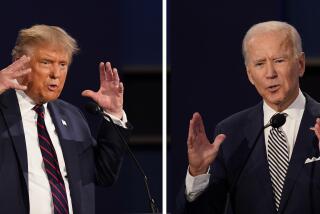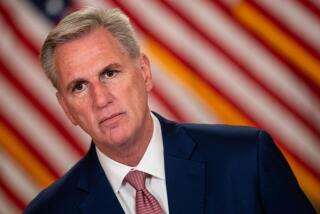Previous clashes with Obama make Paul Ryan an ideal attack dog
- Share via
To say that President Obama and Paul Ryan have a history may be an understatement.
In the 3½ years of Obama’s term, he and the Wisconsin Republican -- tapped Saturday by Mitt Romney to be his running mate in the fall election -- have had a number of significant policy clashes that often played out publicly.
Those face-offs should suit Ryan well as he is set to perform the traditional role of a presidential candidate’s running mate: attack dog, particularly on the Republicans’ focus issue of deficits and debts.
The depth of the Obama-Ryan relationship is a contrast to the one the president has with Romney. Unlike four years ago, when he was running against Senate colleague John McCain, Obama has few personal interactions with the former Massachusetts governor, a factor that has made it all the easier for him to wage a hard-hitting campaign against the all-but-official Republican nominee.
It’s unclear how often Obama and Ryan crossed paths when both served in Congress, at opposite ends of the Capitol. But Ryan emerged as a lead voice for the GOP on fiscal policy once Obama moved across Pennsylvania Avenue to the White House.
The first public confrontation came in January 2010, when the president traveled to Baltimore to speak at the House GOP’s policy retreat. In a rare moment, Obama fielded a number of questions from members on specific policy areas, including one from Ryan, who raised concern about what he described as an 84% increase in the rate of federal spending after Obama’s first year.
With Obama at the time proposing a freeze in domestic spending in his new budget, Ryan said: “I would simply submit that we can do more and start now.”
Obama’s response began by disputing Ryan’s contention that he had increased spending by 84%, pointing out that the federal outlays largely jumped automatically, a consequence of “automatic stabilizers that kick in because of this enormous recession.”
“Whoever was in there, Paul -- and I don’t think you’ll dispute that -- whoever was in there would have seen those same increases,” he said.
He thanked Ryan for his proposal, along with then-Democratic Sen. Russ Feingold, for a constitutional version of the line-item veto, saying there isn’t a president who wouldn’t love to have that tool, which could be used to limit discretionary spending.
“I would love for Congress itself to show discipline on both sides of the aisle. I think one thing that you have to acknowledge, Paul, because you study this stuff and take it pretty seriously, that the earmarks problem is not unique to one party,” he said.
That encounter was a largely polite affair, in which Ryan was one of a handful of House Republicans who posed questions to the president. The event was seen as a public win for the president for how he deftly handled the questions, and spurred calls for further such “prime minister’s questions”-type events.
A month later, Ryan clashed with Obama on the details of the president’s healthcare reform plan, which was within weeks of final passage. Ryan actually targeted Obama on the issue the Democrats will likely focus their campaign against Ryan on in coming months: Medicare.
“What this bill essentially does is treat Medicare like a piggy bank. It raids a half a trillion dollars out of Medicare not to shore up Medicare’s solvency but to spend on this new government program,” he said.
He also warned that, stripped of accounting “gimmicks,” the full long-term costs of reform were far beyond what Democrats claimed.
“There really is a difference between us,” he said at a bipartisan discussion at Blair House, across the street from the White House. “We don’t think the government should be in control of all of this. We want people to be in control. And that, at the end of the day, is the big difference.”
But the major clashes between Obama and Ryan would remain focused on deficit reduction.
Ryan was one of 18 members of the president’s deficit commission, which became known as the Simpson-Bowles panel. It issued a report, called a “Moment of Truth,” that recommended a cap on discretionary spending through 2020, an overhaul of the tax code and reforms to Social Security and Medicare. It would have lowered tax rates overall by simplifying the tax code and eliminating many deductions, which the panel’s leaders called “tax earmarks.”
Eleven of 18 members voted to endorse the plan, but Ryan led the three-member contingent of House Republicans in casting “no” votes that prevented it from advancing for consideration in the full Congress. Ryan raised concerns that implementation of the plan would lead to a public option on healthcare, and ultimately leave Americans paying more in taxes.
Obama himself was cool to the commission’s full report, though would include some recommendations in his own deficit plan unveiled the following year.
In 2011, after Republicans took control of the House and gained seats in the Senate, the GOP tasked Ryan with delivering the party’s response to Obama’s second State of the Union address.
PHOTOS: Mitt Romney names Paul Ryan to ticket
“There’s no doubt the president came into office facing a severe fiscal and economic situation. Unfortunately, instead of restoring the fundamentals of economic growth, he engaged in a stimulus spending spree that not only failed to deliver on his promise to create jobs, but also plunged us even deeper into debt,” Ryan told a national television audience.
Three months later, as lawmakers faced a debate over if and how to raise the nation’s debt limit, the president outlined his own proposal for deficit reduction, detailing a plan to reduce the shortfall by $4 trillion over a decade.
In that speech, with Ryan seated in the crowd, he sharply rebuked the Republican plan.
“This vision is less about reducing the deficit than it is about changing the basic social compact in America,” he said in April at George Washington University. “There’s nothing serious about a plan that claims to reduce the deficit by spending a trillion dollars on tax cuts for millionaires and billionaires. And I don’t think there’s anything courageous about asking for sacrifice from those who can least afford it and don’t have any clout on Capitol Hill. That’s not a vision of the America I know.”
It was a moment that likely ended any real hope of the two working together in a significant way, despite earlier hopes that they could do so.
Behind the scenes, the two leaders would clash again just over a month later, when House Republicans met at the White House to again discuss the debt ceiling. Ryan, rising to speak to the president, joked at how his name had become a political slur for Democrats.
“Hey, I’m that Ryan guy,” he said.
According to participants in the meeting, Ryan went on to say that the warring sides were “not going to make progress on reforming Medicare unless we cut through the demagoguery on the issue.” Ryan himself said he simply sought to have Democrats stop “mischaracterizing” his plan.
Obama would not drop the Medicare attack. And in fact, about a year later, it was the Ryan plan that became the opening salvo of Obama’s campaign against Romney. He quoted the Republican presidential hopeful as describing as “marvelous” a plan he actually said was a “Trojan Horse,” and “thinly veiled social Darwinism,” an attempt “to impose a radical vision on our country.”
It’s a message he, along with Vice President Joe Biden, have continued to press, a case that only gets easier now that Romney and Ryan are officially linked as running mates.
The Obama campaign said Saturday that Biden had phoned Ryan to congratulate him for being named to the ticket, and said he looked forward to a spirited debate.
No word on whether Obama made a similar call.
Follow Politics Now on Twitter
twitter.com/@mikememoli
More to Read
Get the L.A. Times Politics newsletter
Deeply reported insights into legislation, politics and policy from Sacramento, Washington and beyond. In your inbox three times per week.
You may occasionally receive promotional content from the Los Angeles Times.











